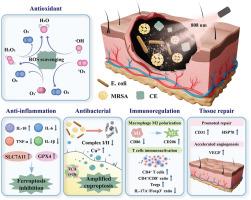Immunomodulatory copper-based polyphenol nanozyme for diabetic infectious wound healing via NIR amplified cuproptosis bacteriostat in synergy with ferroptosis inhibition anti-inflammation
IF 18
1区 医学
Q1 ENGINEERING, BIOMEDICAL
引用次数: 0
Abstract
Diabetic infectious wound is usually in the environment of high glucose levels and immune disorder. It always results in high reactive oxygen species (ROS) levels, serious immune dysfunction, and extreme susceptibility to infection, delaying wound healing. Herein, we prepared an immunomodulatory polyphenol metal organic framework nanozyme (CE) combined with near infrared (NIR) irradiation for diabetic infectious wound healing. This nanozyme was formed by the self-assembly of Cu ions and ellagic acid. In vitro experiments confirmed that CE + NIR could efficiently lower the inflammatory factors (IL-6 (50.72 %), IL-1β (61.44 %) and iNOS (57.33 %)) expression, and upregulate anti-inflammatory factor (IL-10 (111.44 %)) expression of lipopolysaccharide induced RAW264.7, decreasing the ROS levels, promoting cellular migration (527.91 %), and accelerating angiogenesis (91.81 %) of high glucose treated L929, together with inhibiting the bacterial growth of E. coli (92.21 %) and MRSA (95.89 %). Transcriptome sequencing results and their related validation experiments demonstrated that CE + NIR achieved antioxidant and anti-inflammation through ferroptosis inhibition. And transcriptomics and metabolomics analysis proved the efficient antibacterial activity of CE + NIR through NIR amplified cuproptosis. Markedly, it also confirmed that the strategy of CE + NIR was helpful to immunoregulation activation via inducing macrophage M2 directional polarization, and immune activating T cells number, thereby restoring immune homeostasis, and accelerating tissue repair. It might offer an efficient strategy of other infectious diseases’ immunotherapy with high efficacy and biosafety.

免疫调节铜基多酚纳米酶通过近红外放大铜腐菌抑菌剂与铁腐抑制抗炎症协同作用用于糖尿病感染性伤口愈合
糖尿病感染性伤口多发生在高血糖和免疫功能紊乱的环境中。它总是导致高活性氧(ROS)水平,严重的免疫功能障碍,极易感染,延迟伤口愈合。在此,我们制备了一种免疫调节多酚金属有机框架纳米酶(CE)结合近红外(NIR)照射用于糖尿病感染性伤口愈合。该纳米酶由铜离子与鞣花酸自组装而成。体外实验证实,CE + NIR能有效降低脂多糖诱导的RAW264.7中炎症因子(IL-6(50.72%)、IL-1β(61.44%)和iNOS(57.33%)的表达,上调抗炎因子(IL-10(111.44%))的表达,降低高糖处理L929的ROS水平,促进细胞迁移(527.91%),促进血管生成(91.81%),抑制大肠杆菌(92.21%)和MRSA(95.89%)的细菌生长。转录组测序结果及其相关验证实验表明,CE + NIR通过抑制铁下垂实现抗氧化和抗炎症。转录组学和代谢组学分析证实了CE + NIR通过NIR扩增铜绿菌的有效抑菌活性。值得注意的是,这也证实了CE + NIR策略通过诱导巨噬细胞M2定向极化和免疫激活T细胞数量,有助于免疫调节激活,从而恢复免疫稳态,加速组织修复。它可能为其他传染病的高效、生物安全的免疫治疗提供一种有效的策略。
本文章由计算机程序翻译,如有差异,请以英文原文为准。
求助全文
约1分钟内获得全文
求助全文
来源期刊

Bioactive Materials
Biochemistry, Genetics and Molecular Biology-Biotechnology
CiteScore
28.00
自引率
6.30%
发文量
436
审稿时长
20 days
期刊介绍:
Bioactive Materials is a peer-reviewed research publication that focuses on advancements in bioactive materials. The journal accepts research papers, reviews, and rapid communications in the field of next-generation biomaterials that interact with cells, tissues, and organs in various living organisms.
The primary goal of Bioactive Materials is to promote the science and engineering of biomaterials that exhibit adaptiveness to the biological environment. These materials are specifically designed to stimulate or direct appropriate cell and tissue responses or regulate interactions with microorganisms.
The journal covers a wide range of bioactive materials, including those that are engineered or designed in terms of their physical form (e.g. particulate, fiber), topology (e.g. porosity, surface roughness), or dimensions (ranging from macro to nano-scales). Contributions are sought from the following categories of bioactive materials:
Bioactive metals and alloys
Bioactive inorganics: ceramics, glasses, and carbon-based materials
Bioactive polymers and gels
Bioactive materials derived from natural sources
Bioactive composites
These materials find applications in human and veterinary medicine, such as implants, tissue engineering scaffolds, cell/drug/gene carriers, as well as imaging and sensing devices.
 求助内容:
求助内容: 应助结果提醒方式:
应助结果提醒方式:


